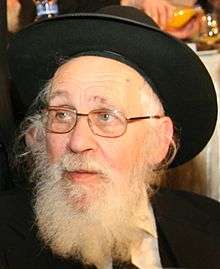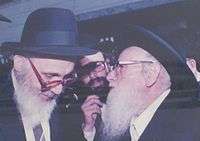Yehoshua Neuwirth
| Rabbi Yehoshua Yeshaya Neuwirth | |
|---|---|
 Rabbi Yehoshua Yeshaya Neuwirth | |
| Position | Rosh yeshiva |
| Yeshiva | Chochmas Shlomo |
| Personal details | |
| Birth name | Yehoshua Yeshaya Neuwirth |
| Born |
February 15, 1927 Germany |
| Died |
June 11, 2013 (aged 86) Jerusalem |
| Profession | Rabbi, posek |
Yehoshua Yeshaya Neuwirth (Hebrew: יהושע ישעיה נויברט) (15 February 1927 - 11 June 2013)[1][2][3] was an eminent[4] Orthodox Jewish rabbi and posek (halakhic authority) in Jerusalem, Israel. He was one of the primary and most renowned students of Rabbi Shlomo Zalman Auerbach and the author of a two-volume Hebrew language treatise, Shemirat Shabbat Kehilchatah — translated into English as Shemirath Shabbath: A practical guide to the observance of Shabbath — a compendium of the laws of Shabbat[5] which is viewed by many as an authoritative work regarding these laws.[6]
Biography
Neuwirth was born in Berlin, Germany. His father Aharon served as rabbi in a number of German communities. After Kristallnacht, he travelled to Belgium on the Kindertransport (children's convoy) but was rejoined by his parents in 1939. They settled in Amsterdam, The Netherlands. During the Second World War, the family lived in hiding, supported by the Resistance. During this time, Neuwirth had little access to rabbinic literature, apart from the volume of the popular work Mishnah Berurah that deals with the Shabbat laws.[7]
In 1946 he immigrated illegally to Israel, and was detained at Atlit camp before being released and travelling to Jerusalem, where he was accepted at the Kol Torah yeshiva. Here he became close to one of its lecturers, Rabbi Shlomo Zalman Auerbach. At Kol Torah he started work on his best-known work on the Sabbath laws.[7] Later, he served as rosh yeshiva in three institutions:[7] the yeshiva Nesivos Chochmah, the Pnei Shmuel yeshiva ketana and Chochmas Shlomo yeshiva gedola in Jerusalem.[7][8] He also established the "Neuwirth Gemach".[9] He lived in the Bayit Vegan neighborhood of Jerusalem.[10]
Works
Rabbi Neuwirth was a leading disciple of Rabbi Shlomo Zalman Auerbach.[11][12] While Rabbi Auerbach issued most of his halachic rulings orally, Rabbi Neuwirth publicized many of his teacher's rulings on the laws of Shabbat in his book, first published in Hebrew in 1965.[13][14] Additionally, 8 of the 32 chapters of this book were devoted to Rabbi Auerbach's rulings on medical halacha.[11][13]
With the publication of his book, Rabbi Neuwirth introduced a new format for studying the laws of Shabbat. While previous texts for general reference were organized according to the presentation in the Shulchan Aruch, Neuwirth's was organised by topic and provided a clear index; he also embellished the presentation with thousands of references and comments.[13] Feldheim Publishers published the first volume of the English-language translation in 1984; volumes 2-4 appeared in 1989, 1997, and 2001, respectively, and the current three-volume boxed set was issued in 2002.[15]

Widely regarded as an expert on Jewish law[16] and medical ethics,[17][18] Rabbi Neuwirth's opinion was frequently cited on issues such as genetic screening,[19] brain death,[20] euthanasia,[6] and AIDS,[21] as well as laws for physicians on Shabbat.[22] He was also a consultant for the Zomet Institute, providing the halakhic authorization for innovations such as the Shabbat lamp[23] and electric wheelchairs on Shabbat.[24]
Bibliography
- Chinukh Ha-Banim Le-Mitzvos Ve-Dinei Katan (Educating Children for Mitzvos and Laws of Youth) (Hebrew)
- The Halachoth of Educating Children[25]
- Kitzur Dinei Shmita Karkaot (Concise Laws of Shmita)
- Shemirat Shabbat Kechilchatah (Hebrew), 1965 — translated into English as Shemirath Shabbath: A guide to the practical observance of Shabbath[15]
References
- ↑ Cohen, Rabbi Uri C. (2006). "Is There an Obligation of Simchah on Shabbat?" (PDF). NDS. p. 24 (note 24). Retrieved 2 January 2011.
- ↑
- ↑ http://www.jewishpress.com/news/breaking-news/rabbi-who-compiled-laws-of-the-sabbath-dies-at-85/2013/06/11/
- ↑ Jachter, Rabbi Chaim (3 February 2006). "Blood Tests and DNA - Part 1". Rabbi Jachter's Halacha Files (and other Halachic compositions). koltorah.org. Retrieved 2 January 2011.
- ↑ Sedley, Rabbi David (2006). "Modern Halachic Books". TorahLab. Retrieved 2 January 2011.
- 1 2 Wagner, Matthew (31 August 2008). "Rabbis: New life-support tech 'murder'". The Jerusalem Post. Retrieved 2 January 2011.
- 1 2 3 4 Hamodia Staff (11 June 2013). "Hagaon Harav Yehoshua Neuwirth, zt"l". Retrieved 2014-04-29.
- ↑ "The Halachoth Of Educating Children (back cover text)". Jewish Used Books. Retrieved 2 January 2011.
- ↑ Shulman, Eliezer; Shimon Breikopf (19 June 2013). "Guardian of the Holy Day". Mishpacha Jewish Family Weekly (464): 44. External link in
|journal=(help) - ↑ Levi, Leo (2004). The Science in Torah: The scientific knowledge of the Talmudic sages. Feldheim Publishers. p. Approbations. ISBN 1-58330-657-9.
- 1 2 Steinberg, Avraham (2008). "Medical-Halachic Decisions of Rabbi Shlomo Zalman Auerbach". The Foundation Stone. Retrieved 2 January 2011.
- ↑ Roth, Rabbi Dan (2007). Relevance: Pirkei Avos for the twenty-first century. Feldheim Publishers. p. 28. ISBN 978-1-58330-935-3.
- 1 2 3 Halperin, Mordechai (2004). "Milestones in Jewish Medical Ethics: Medical-Halachic literature in Israel, 1948-1998" (PDF). ASSIA – Jewish Medical Ethics. Jewish Virtual Library. VI (2): 4–19. Retrieved 2 January 2011.
- ↑ Saltiel, Manny (2011). "Gedolim Yahrtzeits: 20 Adar". chinuch.org. Retrieved 2 January 2011.
- 1 2 Neuwirth, Rav Yehoshua Y. Kechilchathah (2002). Shemirath Shabbath: A guide to the practical observance of Shabbath. ISBN 1-58330-494-0.
- ↑ "Two new Torah scrolls ushered into Shaare Zedek". Shaare Zedek Medical Center. 5 September 2002. Retrieved 2 January 2011.
- ↑ Steinberg, Avraham (2003). Encyclopedia of Jewish Medical Ethics: A compilation of Jewish medical law on all topics of medical interest, from the most ancient sources to the most current deliberations and decisions, with a concise medical and historical background, and a comprehensive comparative analysis of relevant general ethical approaches. Feldheim Publishers. p. lxxiii. ISBN 1-58330-592-0.
- ↑ "Study With Us (Yarchei Kallah)". Jerusalem Center for Research – Medicine and Halacha. 2007. Retrieved 2 January 2011.
- ↑ Eisenberg, Daniel. "Assisted Reproduction in the Conception of Babies with Disabilities". medethics.org. Retrieved 2 January 2011.
- ↑ Zacharowicz, Leon. "Comments to 'Winter Harvest'". Cross-Currents. Retrieved 2 January 2011.
- ↑ Neuwirth, Rabbi Yehoshua (2011). "AIDS: Synopsis of the responsa". Dr. Falk Schlesinger Institute for Medical-Halachic Research. Retrieved 2 January 2011.
- ↑ Abraham, Abraham S. (February 2001). "Halachot for the Physician on the Sabbath and Festivals". ASSAI. Retrieved 2 January 2011.
- ↑ "The Kosher Lamp and Where to Purchase?". jewishcooking.org. Retrieved 2 January 2011.
- ↑ Blicker, Shmuel (6 June 2007). "Technology for Mitzvos" (PDF). Mishpacha Magazine. p. 21. Retrieved 2 January 2011.
- ↑ "The Halachoth of Educating Children". Jewish Used Books. Retrieved 2 January 2011.